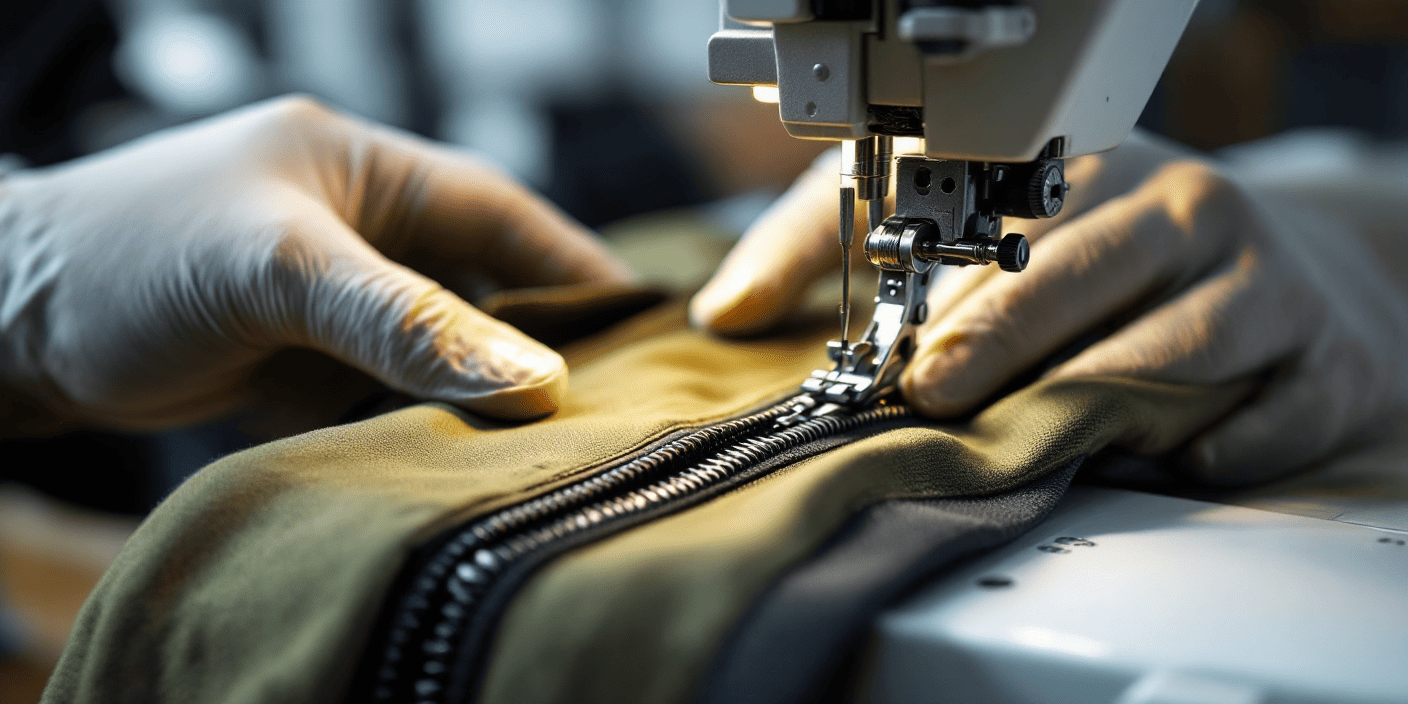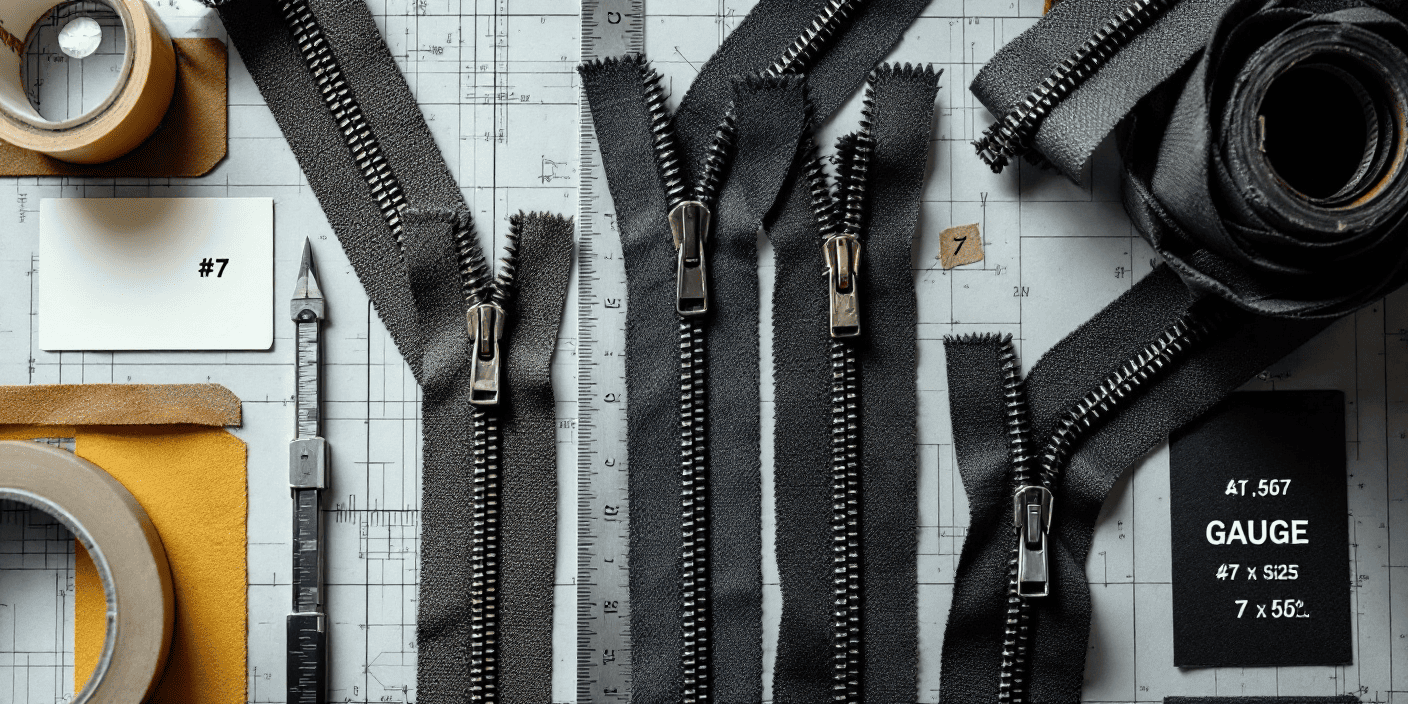Whether you’re stitching your first tote or launching a small line, picking and installing the right zipper is the difference between “works” and “rework.” This guide covers zipper types, gauges, and lengths, beginner-friendly methods, tools, and where to buy—one-off or in bulk—so you can select, sew, and source with confidence.
Quick Guide: Choosing the Right Zipper (TL;DR)
Use this quick path to narrow choices fast. If you’re unsure, skim the Zipper Gauge & Chain Size Chart and this explainer on Choosing the Right Zipper for Your Application.
Step 1: Fabric weight
Lightweight (silk, chiffon, jersey) → #3 nylon coil
Medium (cotton, linen, light denim) → #5 nylon coil or molded plastic
Heavy (canvas, upholstery, leather, heavy denim) → #5–#7 metal or #10 molded plastic
Step 2: Application
Curved seams (bags, pouches) → nylon coil
Straight seams under stress (jackets, jeans) → metal or molded plastic
Concealed closures (formalwear, skirts) → invisible zipper
Exposed style detail → metal with decorative pulls
See comparisons: Coil vs. Molded and Metal vs. Plastic.
Step 3: Length
4–9″ for pouches and pockets
10–22″ for most garments
24″+ for cushions, upholstery, sleeping bags (or continuous chain by the yard and continuous vs. finished)
Step 4: Separating vs. closed-end
Separating = jackets/coats (see Open-End and Two-Way Open-End)
Closed-end = skirts, bags, cushions (Closed-End)
⚠️ Step 5: Match slider & gauge
Slider size must match chain gauge (#3, #5, etc.). Browse Sliders for Zippers and this deep dive: Guide to Zipper Teeth, Sliders & Parts.

Zipper Basics for Sewing
Understanding parts makes installs and fixes easier. Start with Zipper Anatomy, a quick Zipper Glossary, and helpful Zipper Terms You Should Know.
Chain (teeth or coil): nylon coil, molded plastic, or metal — see Zipper Types Explained.
Tape: fabric on both sides of the chain (poly or cotton) — more on The Hidden Role of Zipper Tape.
Slider: opens/closes the chain; sized to gauge.
Stops: top/bottom pieces that keep the slider on.
Separating box & pin (on jackets): allow the two sides to detach.
Separating vs. closed-end matters early—choose before you buy (jump to Open-End vs. Closed-End).
Gauges & Lengths: Decoding the Numbers
Gauge/size ≈ closed-tooth width in mm: #3 ≈ 3 mm, #5 ≈ 5 mm, etc. For quick reference, see the Gauge & Chain Size Chart and the primer on What Is the Difference Between Zippers?.
Common use ranges
#2–#3: delicate fabrics, kidswear, invisible applications
#4–#5: general garments, bags, cushions
#7–#8: outdoor gear, heavy garments, luggage
#10+: tents, marine covers, sleeping bags, upholstery
Length is top stop to bottom stop (ignore extra tape). Need exacts or very long runs? Use Continuous Chain & Specialty Zippers or go straight to Continuous Zippers and the Best Zippers by the Yard.

Types of Zippers for Sewing (With Use Cases)
Nylon Coil
Flexible, light, smooth; sews curves easily and can be cut to length without special tools.
Best for: blouses, skirts, dresses, trousers, bags/pouches, pockets, curved seams.
Limitations: not ideal for high-stress loads.
Learn more: Zipper Types Explained.
Molded Plastic (“VISLON” is a brand term)
Rigid teeth molded to tape; tough and weather-resistant.
Best for: jackets/coats, outdoor gear, bags, kidswear.
Limitations: stiffer; avoid stitching directly over teeth.
Compare: Coil vs. Molded.
Metal
Individual metal teeth; strong with classic/industrial look.
Best for: denim, leather, workwear, structured bags, statement zips.
Limitations: heavier; shortening needs pliers; can corrode in marine use.
Also see finishes/materials: Zipper Materials & Finishes and Zipper Coatings & Finishes.
Invisible (Concealed)
Special coil that hides in the seam; requires an invisible zipper foot.
Best for: formalwear, skirts/dresses, clean-finish cushions/slipcovers.
Decorative & Fancy
Contrast teeth/tape, ring or leather pulls, metallic finishes.
Tip: match pull weight to gauge. If you need unique pulls, explore Where to Find Unique Custom Zipper Pulls.
What’s the “Best” Zipper? It Depends.
Choose for fabric weight, stress, care, and look:
Light fabrics → #3; heavy/stress → molded plastic or metal
Frequent washing/outdoor → coil or molded plastic (no rust)
Aesthetic → metal = statement, invisible = disappears
Decision helpers: Choosing the Right Zipper and How to Read Zipper Spec Sheets.
| Feature | Nylon Coil | Molded Plastic | Metal |
|---|---|---|---|
| Flexibility | Very flexible (great on curves) | Stiffer | Flexible but heavy |
| Strength | Moderate | High | Very high |
| Ease to sew | Easy; won’t shatter needles | Moderate | Hard; don’t sew over teeth |
| Typical uses | Garments, bags, curves | Jackets, outdoor | Denim, leather, workwear |
| Weather | Moderate | Excellent | Poor (corrodes) |
If you’re buying for outdoor/marine, read Choosing the Right Marine-Grade Zippers and Preventing Corrosion for Marine Zipper Care.
Sizing: Short, Standard, Extra-Long
3–9″ → coin purses, pockets, small pouches (often #3 coil)
10–22″ → most garments (#5 coil/molded/metal)
24″+ → cushions, duvets, tents, sleeping bags, boat covers
For long runs and upholstery, consider Custom-Fit, Cut-to-Length Zippers and The Best Cut-to-Length Upholstery Zippers.
How to Shorten a Zipper Safely
Coil / small plastic: mark finished length from top stop → stitch a new bottom stop (wide short zigzag or hand bar tack) → trim ½–1″ below.
Metal / large molded: mark length → remove teeth below the new stop with pliers → add stop → trim between teeth (never through teeth).
Separating zippers: shorten from the top only to preserve the box/pin.
Walkthrough: Step-by-Step Guide to Shortening Zippers.
Tools: Machine, Feet, Needles, Thread
You don’t need a special machine—just the right foot and needle.
Machine & feet: any domestic machine with a straight stitch + zipper foot; invisible foot for invisible zips
Needles: 70/10–80/12 (light); 90/14–100/16 or denim (heavy)
Thread: polyester (strong, slight give)
Stitch length: 2.5–3.0 mm (sewing/topstitch); 4.0–5.0 mm (basting)
Finishing tip: How to Iron Zippers for Perfect Projects.
How to Sew a Zipper (Beginner Walk-Through)
Centered (garments/skirts)
Baste seam closed and press open → place zipper face-down centered over seam → topstitch up one side, across bottom, up the other → remove basting.
Lapped (trousers/dresses)
Baste and press → open zipper and stitch first side to right seam allowance → close zipper, lap the left allowance over to cover teeth → topstitch bottom then up the lapped side.
Exposed (bags/jackets)
Finish raw edges → place zipper face-up on right side → topstitch close to teeth on each side; add a second decorative row if desired.
Checkpoints:
Keep zipper closed while positioning
Start topstitching from the bottom for cleaner corners
Keep the lapped fold even and smooth
Finish edges before exposed installs
Troubleshooting: Zipper Teeth Not Closing and Why Zipper Failure Happens.
Buying Guide: Where to Buy (Retail vs Bulk)
Retail (craft/fabric stores, online marketplaces)
Great for quick one-offs and experiments—no minimums and immediate availability.
Trade-offs: limited gauges/lengths, occasional lot-to-lot color drift, and mixed quality; matching specific sliders/chain types is hit-or-miss. For care basics, read Zipper Maintenance & Care.
Step up to bulk/wholesale when you need:
Consistent color across runs
Continuous chain or very long lengths
Matched sliders and specialty tapes/finishes
Documented quality and repeatable specs (see Zipper Testing Standards, Inside Zipper Testing, and Zipper Load Testing Explained)
Stocking/blanket POs, multi-site shipping, custom pack/label by SKU
Lenzip (U.S.-owned manufacturer): nylon coil, molded plastic, and metal chain; minimums as low as 25 units. Options include continuous chain by the yard, pre-cut lengths, custom colors/finishes, and engineering support to select gauge, slider, and tape.
Explore Custom Zippers, Zipper Material, and Why Choose Lenzip.
Request a quote: Request a Quote – Need help now? Customer Support.
VOC / Finishes Callout (Metal Zippers)
Some plated finishes involve coatings with VOCs. If indoor air quality matters, ask for finish details and documentation. Start with Zipper Coatings & Finishes and Zipper Materials & Finishes.
“Cheap” Zippers Caveat
Ultra-low-cost multipacks often fail at the slider, tooth alignment, or dye consistency. For high-use seams (bags, jackets, upholstery), the rework risk outweighs the savings—use production-grade components from a reputable source.
See also Common Zipper Design Mistakes and How UV Resistance Impacts Outdoor Zipper Lifespan.
Troubleshooting & Pro Tips
Wavy seams/rippling: stabilize with 1″ strips of lightweight interfacing (use knit interfacing on stretch).
Slider jams: clean teeth → light graphite/soap → confirm slider-to-gauge match → replace worn sliders.
Teeth misalignment/separation: reseat top stop; replace if teeth are bent/missing.
Care: close zippers before washing; air-dry metal when possible; occasionally lubricate metal teeth; store zippers flat or loosely coiled.
Deeper reads: Zipper Engineering 101, Inside Zipper Testing, and Zippers in Harsh Chemical Environments.
When to Consider Custom or Bulk Orders
Choose bulk when you need exact color matching, continuous chain or extra-long lengths, matched sliders, specialty tapes/finishes, or stocking programs with predictable releases. If you’re unsure which combination suits your fabric and use case, share details and get a recommendation.
For industry-specific reads: The Ultimate Heavy-Duty Zipper Guide, Heavy-Duty Zippers for Emergency Responders, and Why Zippers Matter in Healthcare.
Lenzip: MOQ 25, engineering support, custom lengths/colors, stocking options — Custom Zippers – Request a Quote – Customer Support
FAQs
What’s best for beginners?
Nylon coil (#3/#5). See Zipper Types Explained.
Do I need a special machine?
No—use a zipper foot; invisible zips need an invisible foot. Finish like a pro with How to Iron Zippers.
How do I pick a gauge?
Match fabric and stress: #3 light, #5 general, #7–#10 heavy. Use the Gauge Chart.
Can I shorten metal/molded?
Yes—remove teeth below the new stop; don’t cut through teeth. Step-by-step: Shortening Zippers.
Invisible vs regular?
Invisible hides in the seam; regular is topstitched/visible.
Where to buy long/bulk?
From manufacturers/distributors. Start here: How to Buy Zippers in Bulk and Continuous Zippers. Lenzip offers MOQ 25, custom lengths/colors, and support—Request a Quote.
